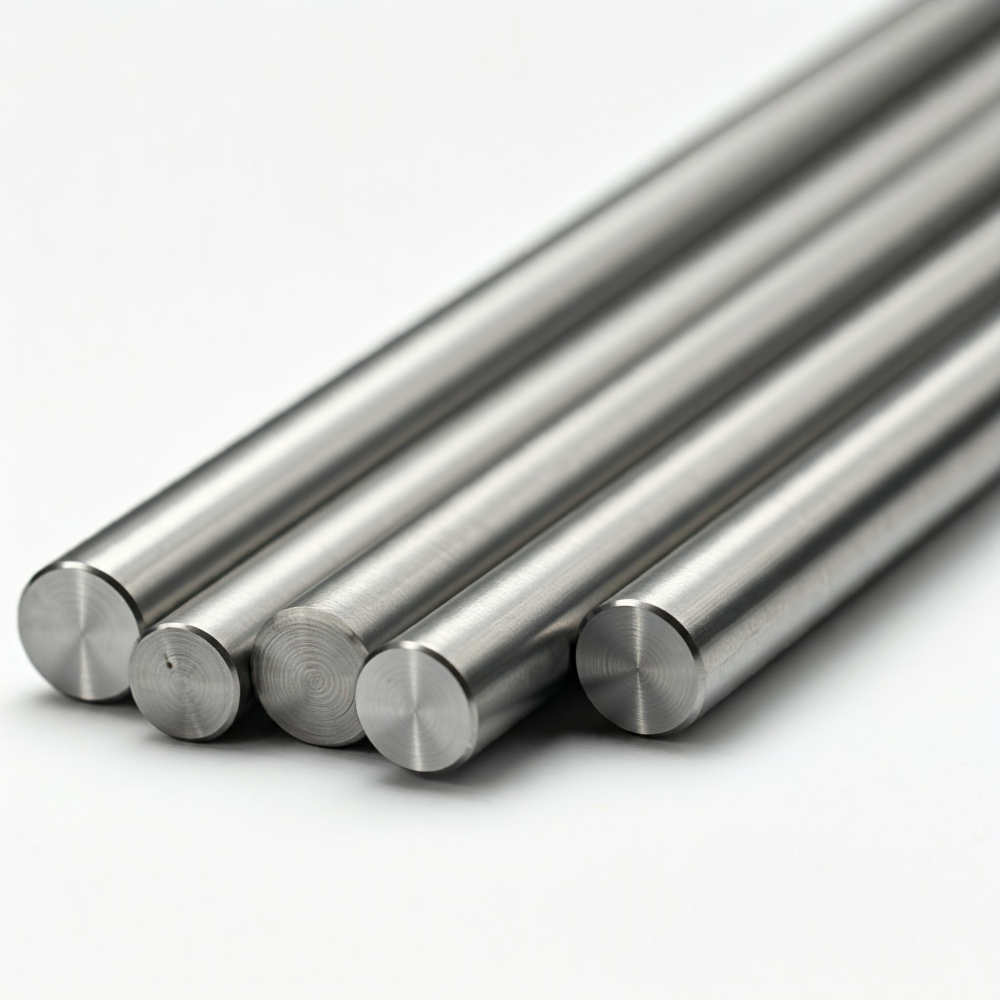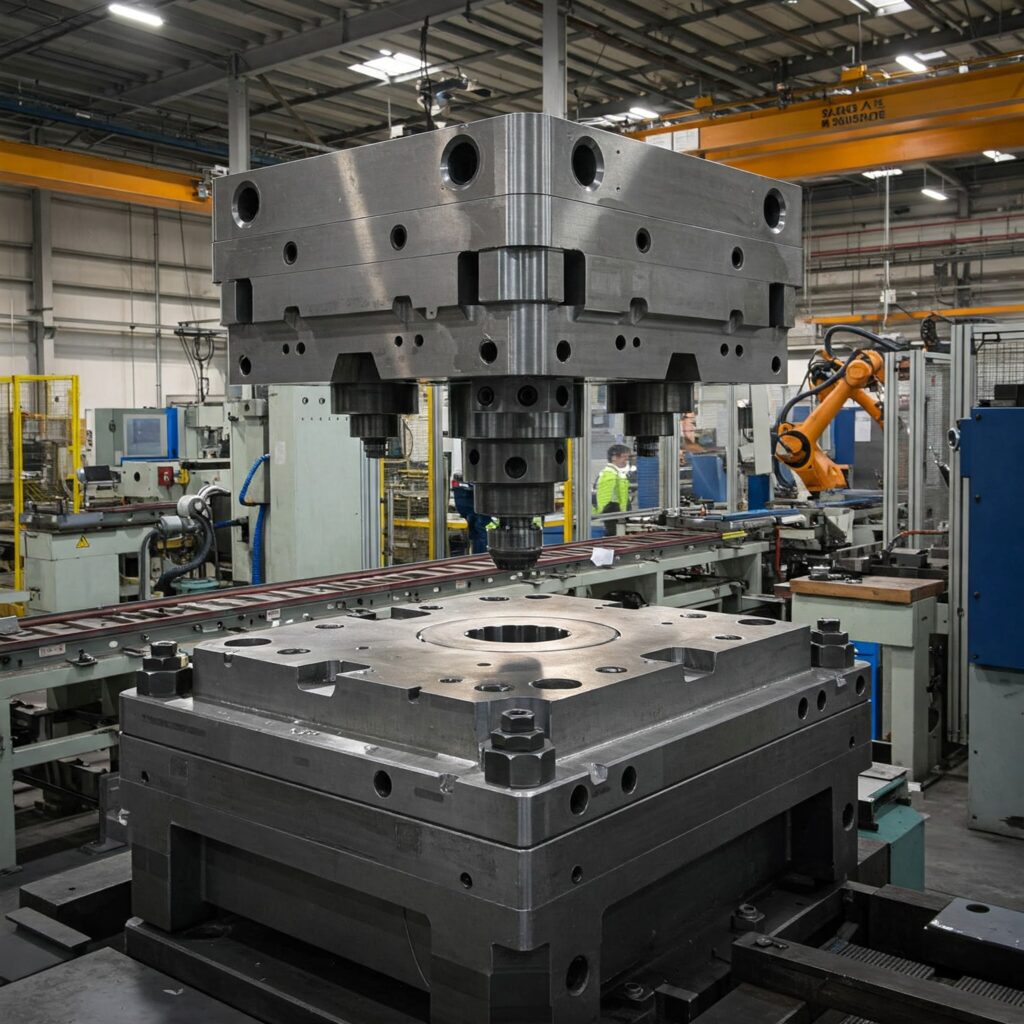Orodno jeklo H11 in Orodno jeklo H13 sta oba orodna jekla za vroče delo. Spadajo v serijo H sistema Ameriškega združenja za testiranje in materiale (ASTM).
H11 in H13 sta predstavnika orodnih jekel za vroče delo. Ponujajo dobro razmerje med stroški in zmogljivostjo, zaradi česar so referenčna točka za različne aplikacije v kalupih za vroče oblikovanje. Ti materiali so bili prvotno razviti za tlačno litje in kažejo visoko kaljivost, minimalno deformacijo med toplotno obdelavo, minimalno nagnjenost k oksidaciji, dobro zmogljivost popuščanja, odpornost proti koroziji tekočega aluminija in visoko odpornost proti toplotni utrujenosti.
Glavna razlika med jeklom H11 in H13 je, da H13 vsebuje približno 0,5% več vanadija. Ta dodatna vsebnost vanadija dodatno poveča vročo trdoto in odpornost proti popuščanju, lahko pa tudi rahlo zmanjša žilavost, zlasti med kaljenjem in popuščanjem.
H13 je nekoliko bolje odporen na mehčanje po toplotni obdelavi, vendar je njegova žilavost nekoliko nižja. V primerjavi s H11 ima lahko H13 neenakomerno porazdelitev vanadijevih karbidov. To je še posebej pomembno v pogojih homogenizacije proizvodnje za povečanje žilavosti.
Ta članek primerja H11 in H13 na podlagi določenih podatkov. Nekateri podatki izvirajo iz literature in so bili ustrezno citirani.
Kemična sestava h11 in H13
| Vrsta AISI | UNS št. | C (%) | Mn (%) | Si (%) | Cr (%) | Ni (%) | Mo (%) | W (%) | V (%) |
| H11 | T20811 | 0.33-0.43 | 0.20-0.50 | 0.80-1.20 | 4.75-5.50 | 0,30 maks | 1.10-1.60 | … | 0.30-0.60 |
| H13 | T20813 | 0.32-0.45 | 0.20-0.50 | 0.80-1.20 | 4.75-5.50 | 0,30 maks | 1.10-1.75 | … | 0.80-1.20 |
Primerjava glavnih dejavnikov orodnega jekla H11 in H13
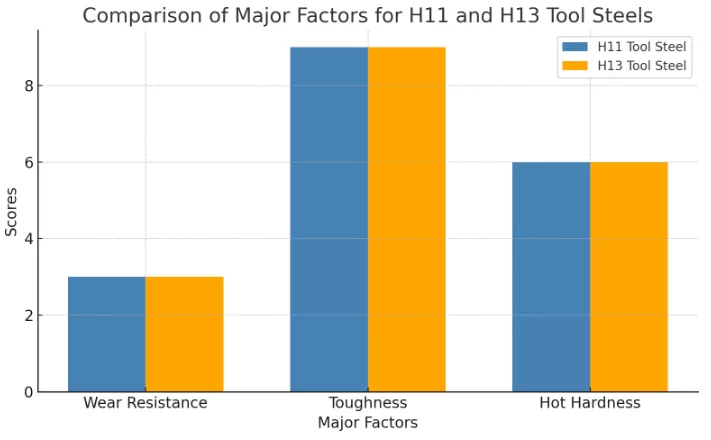
- Odpornost proti obrabi: H11 in H13 imata enako vrednost 3, kar kaže na enako odpornost proti obrabi.
- Žilavost: Oba imata vrednost 9, kar kaže na visoko žilavost obeh vrst.
- Vroča trdota: Oba imata enako vrednost 6, kar kaže na podobno vročo trdoto.
Na podlagi te tabele se zdi, da imata H11 in H13 zelo podobne lastnosti glede odpornosti proti obrabi, žilavosti in trdote pri vročem.
Primerjava proizvodnih faktorjev za orodna jekla H11 in H13
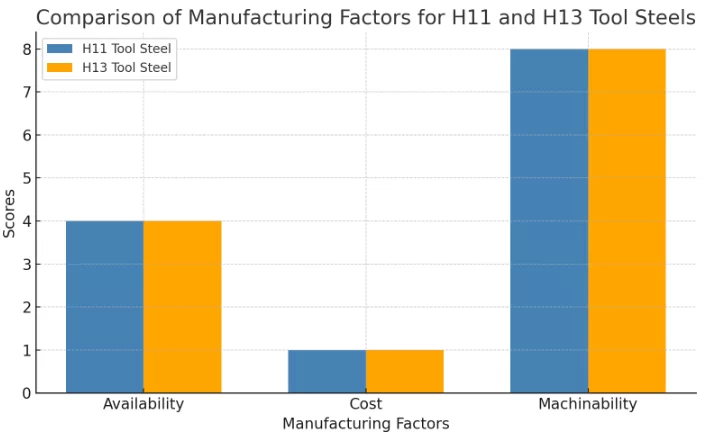
- Razpoložljivost: Tako orodno jeklo H11 kot H13 imata oceno razpoložljivosti 4, kar nakazuje, da sta enako dostopna.
- Cena: Obe vrsti jekla imata stroškovno oceno 1, kar pomeni, da imata podobno ceno.
- Obdelovalnost: Tako H11 kot H13 imata oceno obdelovalnosti 8, kar nakazuje, da ju je relativno enostavno obdelati.
Tabela kaže, da sta si orodna jekla H11 in H13 podobna glede teh treh proizvodnih dejavnikov.
Primerjava drugih parametrov
| Faktor | Orodna jekla H11 | Orodna jekla H13 |
| Običajna delovna trdota, HRC | 38-55 | 40-53 |
| Globina utrjevanja | D | D |
| Najfinejša velikost zrn pri polni trdoti, Shepherd standard | 8 | 8 |
| Površinska trdota po kaljenju, HRC | 53-55 | 51-54 |
| Trdota jedra (25 mm ali 1 in., diam okrogel), HRC | 53-55 | 51-54 |
| Medij za kaljenje | A | A |
| Temperatura strjevanja, °C (°F) | 995-1025 (1825-1875) | 995-1040 (1825-1900) |
| Sprememba dimenzij pri utrjevanju | L | L |
| Varnost pri utrjevanju | H | H |
| Občutljivost za razogljičenje | H | H |
| Približna trdota valjanega ali kovanega, HB | 500 | 500 |
| Žarjena trdota, HB | 192-229 | 192-229 |
| Temperatura žarjenja, °C (°F) | 845-900 (1550-1650) | 845-900 (1550-1650) |
| Območje kaljenja, °C (°F) | 540-650 (1000-1200) | 540-650 (1000-1200) |
| Temperatura kovanja, °C (°F) | 1065-1150 (1950-2100) | 1065-1150 (1950-2100) |
Orodna jekla H11 in H13 imajo veliko podobnosti glede mehanskih lastnosti, toplotna obdelava lastnosti in zmožnosti kovanja. Glavna razlika je v njihovem območju trdote, pri čemer H13 ponuja nekoliko višjo trdoto za zahtevnejše aplikacije. Izbira med tema dvema jekloma je odvisna od posebnih zahtev predvidene uporabe, kot so potrebna stopnja odpornosti proti obrabi, žilavost in dimenzijska stabilnost.
Natezne lastnosti orodnih jekel H11 in H13 pri povišanih temperaturah
| Vrsta jekla | Testna temperatura (°C) | Testna temperatura (°F) | Natezna trdnost (MPa) | Natezna trdnost (ksi) | Meja tečenja (odmik 0,2%) (MPa) | Meja tečenja (odmik 0,2%) (ksi) | Raztezek (50 mm) (%) | Zmanjšanje površine (%) | Trdota pri sobni temperaturi (HRC) Pred testiranje | Trdota pri sobni temperaturi (HRC) Po testiranje |
| H11 | Soba | Soba | 1806 | 262 | 1482 | 215 | 10 | 35.8 | 50 | 50 |
| 150 | 300 | 1689 | 245 | 1358 | 197 | 10.1 | 36.1 | 50 | 50 | |
| 260 | 500 | 1600 | 232 | 1345 | 195 | 9.8 | 34.5 | 50 | 50 | |
| 345 | 650 | 1579 | 229 | 1317 | 191 | 10 | 35.2 | 50 | 50 | |
| 425 | 800 | 1510 | 219 | 1289 | 187 | 11.4 | 38.7 | 50 | 50 | |
| 480 | 900 | 1427 | 207 | 1145 | 166 | 12.2 | 38.9 | 50 | 50 | |
| 540 | 1000 | 1241 | 180 | 965 | 140 | 11 | 35.4 | 50 | 50 | |
| 595 | 1100 | 979 | 142 | 724 | 105 | 12.8 | 46.2 | 50 | 47 | |
| 650 | 1200 | 586 | 85 | 434 | 63 | 18.9 | 66.6 | 50 | 41 | |
| H13 | 480 | 900 | 1531 | 222 | – | – | 9 | 37 | 52 | – |
| 540 | 1000 | 1413 | 205 | – | – | 11 | 43 | 52 | – | |
| 595 | 1100 | 1193 | 173 | – | – | 15 | 49 | 52 | – | |
| 650 | 1200 | 814 | 118 | – | – | 22 | 59 | 52 | – |
Opomba:
- »-« v stolpcih meje tečenja za jeklo H13 pomeni, da podatki niso bili na voljo.
- Stolpec Trdota pri sobni temperaturi (HRC) prikazuje vrednosti pred in po testiranju, ločene z vejico.
- Podatki Teledyne VASCO. Allegheny Ludlum Industries in Universal-Cyclops Steel Corp.
CVN udarna žilavost orodnih jekel H11 in H13 kot funkcija preskusne temperature.
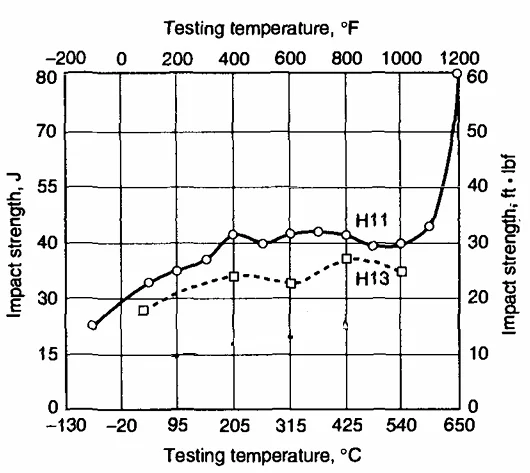
Ta graf nakazuje, da postaneta H11 in H13 bolj odporna na udarce pri višjih temperaturah. Vendar pa je H13 bolj občutljiv na temperaturne spremembe, kar kaže na pomembnejše povečanje udarne trdnosti z naraščajočimi temperaturami.

